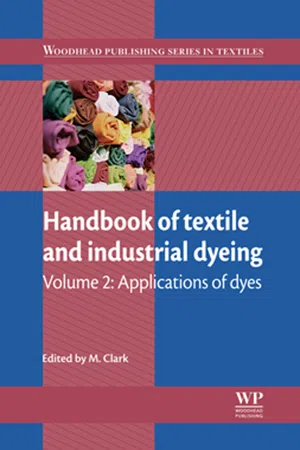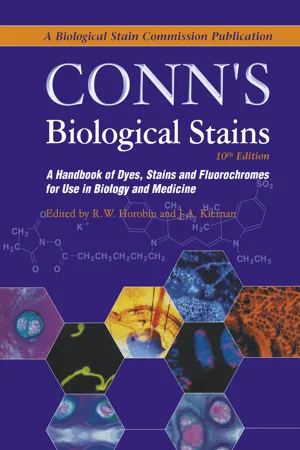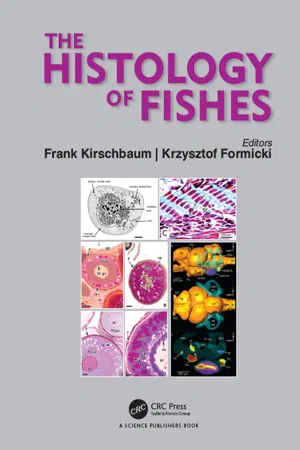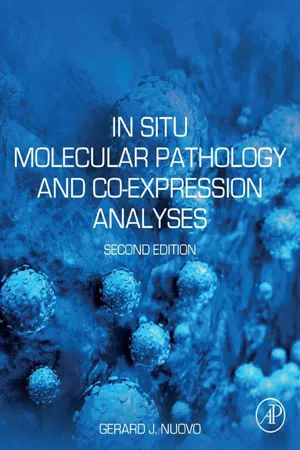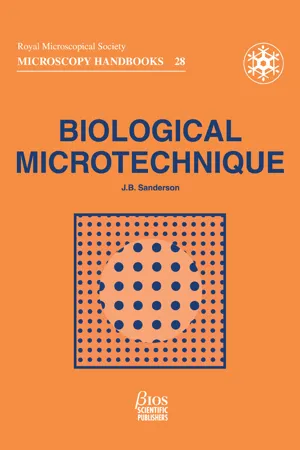Biological Sciences
Tissue Staining
Tissue staining is a technique used to enhance the visibility of specific structures within biological tissues. It involves the application of dyes or chemicals that selectively bind to certain components of the tissue, allowing them to be distinguished under a microscope. This process is widely used in histology and pathology to aid in the identification and analysis of cellular and tissue structures.
Written by Perlego with AI-assistance
Related key terms
Related key terms
1 of 4
Related key terms
1 of 3
6 Key excerpts on "Tissue Staining"
- eBook - ePub
Handbook of Textile and Industrial Dyeing
Volume 2: Applications of Dyes
- M Clark(Author)
- 2011(Publication Date)
- Woodhead Publishing(Publisher)
Colouring biological samples is similar, in scientific principle, to textile dyeing. In both areas, dyes are added to a material with the object of dye molecule attachment, usually to a polymeric substrate. However, where in textiles the chemical make-up of the substrate is well established – cotton/cellulose, silk/protein, etc. – allowing considerable control of the resulting colour and shade, biological samples are usually a complex chemical mixture, the resulting colour and colour distribution depending on the relative proportions of different biopolymers. The proportion and distribution of these biopolymers will also vary depending on the growth phase and age of the cell.As mentioned above, the Gram staining procedure provides the cornerstone of rapid identification of bacteria in our hospitals. The process was developed by the Dane, Christian Gram in 1884 – pioneering work in an era which was less than accepting of the ‘Germ Theory’ of disease. Such research, built upon by contemporary scientists such as Robert Koch, Paul Ehrlich and others (Leishmann, Romanovsky, Giemsa – the list is fairly substantial) eventually developed into the scientific branch of histology (Wainwright, 2003b ). Specialisms within histology include histopathology, i.e. the study of disease processes via staining, which is really what Gram and subsequent workers set out to do. Modern medical laboratory scientific officers carry out such bacterial staining routinely, alongside further biochemical testing to give information on specific strains of bacteria, particularly in terms of drug susceptibility.Biological stains thus remain of immense importance in modern medicine from the point of view of infection control. However, cell staining is much more extensive than just the differentiation of bacterial and human cells.Usually, medical microbiologists examine cell samples taken from patients. These samples normally include blood, sputum, urine, faeces or tissue swabs, depending on the disease presentation. The process then runs along the lines of ‘Is there an infective organism here? If so, what is it?’ Other disease states may not be so easy to pinpoint – for example where the problem lies in human cell differentiation. Obviously, if such differentiation is required within the live patient, there are more stringent requirements in terms of dye toxicity (q .v - eBook - ePub
Conn's Biological Stains
A Handbook of Dyes, Stains and Fluorochromes for Use in Biology and Medicine
- Richard Horobin, John Kiernan(Authors)
- 2020(Publication Date)
- Taylor & Francis(Publisher)
A few accounts have emphasized the single set of physicochemical factors operating in all methodologies. In English there are the scholarly books of John Baker (Baker, 1958), various monographs by Horobin (1982, 1988) and Horobin and Bancroft (1998) and Lyon (1991), and more recently a fascinating review by Prento (2001). Such accounts have a characteristic fate: they are widely cited, but their larger message is ignored.Basic concepts and terminologyThe purpose of biological staining is to generate information, most often to address the following questions.(i) What is this, that we see in the microscope?(ii) Where is this found, within the cell, tissue or organism?(iii) How much of this is there, or how many of them are present?To provide answers a staining method must be sufficiently sensitive to detect the biological target. This often depends upon the amount of material present, and on the precise mode of action of the stain. Other things being equal fluorescent reagents and catalytic staining processes favor high sensitivity. Fluorescent reagents provide a superior signal to noise ratio in the microscope, whereas catalytic staining processes allow sensitivity to be increased by prolonging staining times. With most stains, selectivity is as important as sensitivity. Biological targets must often be stained differently from adjacent structures before identification is possible. Consequently an understanding of the mode of action of a staining method requires answers to two key questions:(i) Why does anything stain?(ii) Why doesn’t everything stain in the same way?This chapter provides answers to these questions. Although factors controlling sensitivity and selectivity are numerous, the same physicochemical phenomena are important whatever the staining methodology. Thus electric charges carried by dyes and biopolymers determine the selectivity of acid and basic dyes, and also influence the action of fluorescently labeled antibodies. The sizes of dye ions can control staining patterns, and the sizes of labeled antibody molecules critically influence sensitivity in the immunostaining of resin sections. - eBook - ePub
Insect Histology
Practical Laboratory Techniques
- Pedro Barbosa, Deborah Berry, Christina K. Kary(Authors)
- 2014(Publication Date)
- Wiley-Blackwell(Publisher)
Chapter 5 Immunohistochemical techniques 5.1 Introduction Whereas the dye-based stains noted in Chapter 4 are powerful tools for identification of specific structures and organelles or biochemical properties of the cell or tissues, Immunostaining (or Immunohistochemistry (IHC)) refines this further through the use of protein-specific antibodies to localize and quantitate individual proteins. IHC can be performed on tissue sections or on whole (small) animals or tissues for in vivo, three-dimensional localization. Bound primary antibodies can be detected in a number of ways, including direct labeling methods, indirect labeling methods that allow for amplification of signal, and chromogenic methods for routine pathology. Advanced and highly informative techniques also include fluorogenic methods (see Chapter 7 Fluorescence for Additional Protocols) that allow tight and specific labeling as well as quantification of intensity, and electron dense particle labeling methods for combination of IHC with electron microscopy for unparalleled, sub-cellular localization of proteins. Individual antibodies vary in their ability to bind fixed tissue and tissues can vary in their ability to allow penetration of antibodies generally. As such, a variety of IHC procedures are presented to cover the complexity of labeling approaches and variations in antibodies and tissues to be studied. Where one protocol may work beautifully for a specific antibody on a particular tissue, a different antibody or a different tissue may require an entirely different protocol - eBook - ePub
- Krzysztof Formicki, Frank Kirschbaum(Authors)
- 2019(Publication Date)
- CRC Press(Publisher)
A dye molecule contains two elements: a chromogen and an auxochrome. The chromogen is a colored part and consists of a specific arrangement of atoms—a chromophore, which is responsible for the absorption of visible light. The auxochrome, responsible for attaching the chromogen to the substrate, is a part of the ionizable substituent, or a substituent that reacts to form a covalent bond or coordinate with metal (mordant) ion. When auxochromes are amines, they are classified as basic (cationic) dyes, whereas when they are derived from carboxylic, sulphonic acids or from phenolic hydroxyl groups, they are acid (anionic) dyes.Staining of sections, after removing the paraffin wax, is performed in large excess of staining solution at room temperature. When a solution of a dye is allowed to act slowly until the desired effect is obtained the staining is progressive, whereas in regressive staining the tissue is overstained, and is followed by the process of differentiation, which is a controlled removal of the dye in the staining process in water or alcohol. The success of staining depends on the affinities of the dyes to some components of tissues.Histological staining methods are usually selected according to the type of microscope (LM, TEM, fluorescent microscopes) and of the biological tissue to be observed. There are many different histological staining techniques suitable for examination of particular components of tissues or types of cells. The most popular staining techniques are described below.Haematoxylin and eosin (H&E stain) method is commonly used more than any other technique in general histology. Haematoxylin is a basic dye, which binds and stains nucleic acids (DNA and RNA), thus it stains the nuclei of cell. Eosin, an acidic dye, stains the cytoplasm pink. There are many haematoxylin methods used in laboratories today. For example: the alum-based haematoxylin introduced by Ehrlich (1886) or Mayer (1903), Weigert’s iron haematoxylin introduced in 1904 used in trichrome methods, or Harris’s method (1900) resulting in a shorter staining time (Titford 2009).There is a multitude of histological methods for connective tissues, which are based on the use of the mixtures of anionic dyes that stain in different colors collagen and cell cytoplasm. The first reported triple stains were made by Gibbes in 1880 (Bracegirdle 1986). The most popular trichrome stains in present time are: Mallory’s, Masson’s trichrome and Van Gieson methods. The trichrome stain is a complex method, in which tissues of different fine structure and consistency are stained by dyes with small molecules staining tissues with very fine structures, and larger molecules dyes staining more porous tissues. In different trichrome methods, phosphotungistic acid is used as this compound enhances the dye’s affinity to collagen (Putchtler and Isler 1958). Many methods such as Verhoeff’s or orcien stain are used to demonstrate elastic fibers in connective tissues, whereas reticulin fibers, also called argyrophilic tissue because of its affinity to silver salts, are identified by various silver stains. - Gerard J. Nuovo(Author)
- 2020(Publication Date)
- Academic Press(Publisher)
Chapter 8The basics of histologic interpretations of tissues
Abstract
A major power of in situ hybridization and immunohistochemistry is that each method allows the investigator to determine which specific cell type or types contain the DNA, RNA, or protein target of interest. To maximize this strength, you must be able to identify, when looking under the microscope, the cell types that contain the target of interest. Even if you have no background in the histologic interpretation of tissues, this task is not as difficult as it may sound. This chapter is dedicated to the investigator who has no prior experience in looking at tissues under the microscope. By offering a simplified approach that focuses on three groups (epithelial, stromal, and inflammatory), this chapter can help you learn to identify the different categories of cells that exist in each tissue. The chapter also discusses how immunohistochemistry is the mainstay of determining the phenotype of a given cell in diagnostic pathology, and how this can be exploited via coexpression analyses to determine what specific cell type contains a target of interest.Keywords
Epithelial; stromal; inflammatory cells; lymphocyte; plasma cell; macrophage; neutrophil; squamous; glandularIntroduction
One of the more challenging parts of molecular pathology is that it truly requires two separate and distinct skill sets. For one, you must have a thorough foundation in the basics of molecular biology. An understanding of stringency, homology, the biochemistry of the three-dimensional protein/protein cross-linked network, and so on, is essential for you to become very good at in situ molecular pathology. However, this is not enough. You may have generated the most beautiful immunohistochemistry or in situ hybridization data for a new protein or gene in a formalin-fixed, paraffin-embedded cancer tissue. The pattern may provide enormous insight into the role of that specific protein or RNA into oncogenesis. However, if you cannot interpret that pattern, this information will remain hidden. Obviously, the best way to address this potential situation is to take a course in histopathology. However, that is not practical for a lot of people. Thus, I have written this chapter, in general, for the investigator with no formal training in histopathology. My goal is not to make you capable of diagnosing complex tumors. My goal is to make you able to quickly, confidently, and accurately determine what specific cell type or types contain your target of interest when you perform immunohistochemistry or in situ hybridization. However, if you have formal surgical pathology training, I have included more complex histopathological issues toward the end of the chapter that you may find interesting and challenging!- eBook - ePub
- Jeremy Sanderson(Author)
- 2020(Publication Date)
- Garland Science(Publisher)
Whilst standardization has not procluded the successful use of stains, the rational use of standardized dyes permits better and more consistent staining, and the wider use of automatic staining equipment. It is not feasible to produce very pure dyes economically, because the majority of the market caters not for the biologist, but for the textile industry. The single most important barrier to the production of analytical grade dyes, however, is the isolation and characterization of the individual components in what is a very complex mixture. Purifying large quantities of ionized dyes is difficult when the ionic components adsorb easily onto the carrier substratum.The Biological Stain Commission assays commercial dyes, and certifies those which perform well in routine tests and which meet certain physicochemical standards (Lillie, 1977), and the European Committee for Clinical Laboratory Standards has reported in the Histochemical Journal (1992) on dye standards for several specific dyes. There is also an excellent review of standardization in biological staining by Schulte (1991).The best practical advice is first to use only those stains which have been certified, and to note the batch number of the relevant dye. About 60 dyes are now routinely certified, and all reputable manufacturers submit their products for certification before sale, although staining solutions of dyes are not certified. Secondly, where it is crucial to eliminate a false result (positive or negative) from a particular staining technique, it is usual to take a known positive control through the protocol. Suitable control tissues are listed in Appendix 4 of Bancroft and Cook (1984).References
Baker JR. (1958) Principles of Biological Microtechnique: a Study of Fixation and Dyeing. Methuen, London.Baker JR. (1964) A substitute for Ehrlich’s haematoxylin and similar dyes used in biological microtechnique. School Sci. Rev. 45, 400–401.Baker JR, Jordan BM. (1953) Miscellaneous contributions to microtechnique. Q. J. Microscop. Sci. 94
Index pages curate the most relevant extracts from our library of academic textbooks. They’ve been created using an in-house natural language model (NLM), each adding context and meaning to key research topics.
Explore more topic indexes
Explore more topic indexes
1 of 6
Explore more topic indexes
1 of 4
